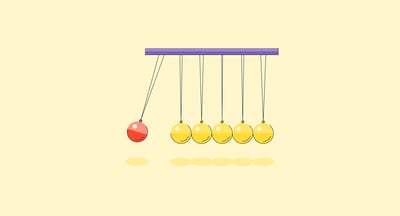You don’t need to be an ML expert to forecast effectively. With K-nearest neighbor (KNN), you can bring predictive intelligence into business decisions. Now, businesses want to remain ahead in the AI race by building more supervised ML applications and fine-tuning algorithms. While algorithms can get too technical, there are easy and intuitive techniques, like K-nearest neighbor, that enable data classification and regression to improve your strategic predictions.
Teams using data analytics platforms like Tableau or Power BI often embed KNN-based classifiers to power fraud detection, sales predictions, or churn modeling.
KNN’s flexibility means it powers everything from fraud detection systems to recommendation engines. Here’s how it fits into business workflows.
K-nearest neighbor (KNN) is a supervised machine learning algorithm that classifies or predicts outcomes based on the 'K' most similar data points in the training dataset. It's non-parametric and doesn’t involve a training phase, which is why it's often called a lazy learner or instance-based learner.
Since KNN predicts based on proximity rather than internal model weights or parameters, it’s easy to interpret and quick to prototype, making it a go-to algorithm for exploratory data analysis and real-time decision support.
A simple KNN example would be feeding the neural network or NN model a training dataset of cats and dogs and testing it on an input image. Based on the similarity between the two animal groups, the KNN classifier would predict whether the object in the image is a dog or a cat.
Unlike traditional models that require heavy upfront training, KNN takes a more relaxed approach. It stores the data and waits until a prediction is needed. This just-in-time strategy earns it the nickname “lazy learner” and makes it especially useful for tasks like data mining, where real-time analysis of large historical datasets is key
Did you know? The "K" in KNN is a tunable parameter that determines how many neighbors to consult when classifying or predicting. A good value of K balances between noise sensitivity and generalization.
It's considered a non-parametric method because it doesn’t make any assumptions about the underlying data distribution. Simply put, KNN tries to determine what group a data point belongs to by looking at the data points around it.
When you feed training data into KNN, it simply stores the dataset. It doesn’t perform any internal calculations, transformations, or optimizations during this time. The actual "learning" happens at prediction time, when the algorithm compares a new data point to the stored training data.
Because of this deferred computation, KNN is sometimes called an "instance-based learner" or "smart learner". This characteristic makes it a strong fit for data mining, where real-time inference from large, historical datasets is common.
Below is a fully commented, end-to-end KNN Python example using Sci-Kit Learn. It shows how to load data, scale features, choose K, and evaluate performance. Paste it into a Jupyter notebook or script to see KNN in action.
This example highlights the practical simplicity of KNN, no training phase, minimal assumptions, and a clear prediction logic rooted in spatial relationships. With just a few lines of Python and scikit-learn, you can quickly prototype a classification model and iterate using different K values, distance metrics, and weighting strategies.
While KNN is beginner-friendly, it rewards thoughtful tuning-especially in terms of feature scaling and hyperparameter selection.
KNN takes an intuitive approach: it doesn’t learn ahead of time, but it predicts by comparing new data to existing labeled examples. Here’s how it works:
Let’s illustrate with a practical example using a scatter plot containing two groups: Group A and Group B.
This voting mechanism scales smoothly to multi-class problems as well, and whichever class receives the most neighbor votes wins.
Programming languages like Python and R are used to implement the KNN algorithm. The following is the pseudocode for KNN:
To validate the accuracy of the KNN classification, a confusion matrix is used. Statistical methods, such as the likelihood-ratio test, are also used for validation.
In regression analysis, the majority of steps are the same. Instead of assigning the class with the highest votes, the average of the neighbors’ values is calculated and assigned to the unknown data point.
K-nearest neighbor (KNN) uses distance metrics to measure similarity between data points and determine the nearest neighbors.
The choice of metric directly affects the model's accuracy, especially in datasets with varying scales, mixed data types, or outliers. Here's how the most common geometrical distance metrics compare:
| Metric | Formula (conceptual) | Best used for | Pros | Cons |
| Euclidean (L₂) | Square root of the sum of squared differences | Continuous, low- to mid-dimensional data | Intuitive and widely used | Sensitive to scale and irrelevant features |
| Manhattan (L₁) | Sum of absolute differences | High-dimensional, sparse datasets | More robust to outliers; simple math | Less intuitive to visualize |
| Minkowski (Lₚ) | Generalized form that includes L₁ and L₂ | Tunable similarity for hybrid datasets | Flexible; interpolates between L₁ and L₂ | Requires setting and tuning the p parameter |
| Hamming | Count of differing elements | Binary or categorical data (e.g., strings) | Ideal for text, DNA sequences, and bitwise encoding | Not suitable for continuous or numerical variables |
Always scale your features (via normalization or standardization) when using distance-based metrics like Euclidean or Minkowski to ensure fair comparisons across features.
Understanding these distance functions sets the foundation for where KNN truly shines and can be commercially used across industries today.
From tuning hyperparameters to deploying in production, building effective KNN models requires the right tools. G2 features real reviews on data science and machine learning platforms (DSML) that support training, validation, and scaling, so you can choose what fits your workflow best.
Compare the best data science and machine learning platforms now.
Classification is a critical problem in data science and machine learning. The KNN is one of the oldest yet accurate algorithms for pattern classification and text recognition.
Here are some of the areas where the k-nearest neighbor algorithm can be used:
Apart from these applications, KNN is frequently used to determine business trends, revenue forecasts, and strategic investment-based ML models to minimize risk and improve the accuracy of the outcomes.
There isn't a specific way to determine the best K value; in other words, the number of neighbors in KNN. This means you might have to experiment with a few values before deciding which one to go forward with.
One way to do this is by considering (or pretending) that a part of the training samples is "unknown". Then, you can categorize the unknown data in the test set by using the k-nearest neighbor algorithm and analyze how good the new categorization is by comparing it with the information you already have in the training data.
When dealing with a two-class problem, it's better to choose an odd value for K. Otherwise, a scenario can arise where the number of neighbors in each class is the same. Also, the value of K must not be a multiple of the number of classes present.
Another way to choose the optimal value of K is by calculating the sqrt(N), where N denotes the number of samples in the training data set.
However, K with lower values, such as K=1 or K=2, can be noisy and subject to the effects of outliers. The chance of overfitting is also high in such cases.
On the other hand, K with larger values will, in most cases, give rise to smoother decision boundaries, but it shouldn't be too large. Otherwise, groups with fewer data points will always be outvoted by other groups. Plus, a larger K will be computationally expensive.
KNN is widely appreciated for its simplicity and flexibility. With minimal configuration, it can be applied to a broad range of real-world problems, especially when accuracy and transparency are priorities over speed or scalability.
Of course, KNN isn't a perfect machine learning algorithm. Since the KNN predictor calculates everything from the ground up, it might not be ideal for large data sets.
Despite its strengths, KNN isn't without limitations. The same simplicity that makes it accessible can lead to performance bottlenecks, especially when dealing with large or high-dimensional data.
While ML is a low-level ML technique, it is still prominently used by data science and machine learning teams to leverage regression analysis for real-world problems.
When you have massive amounts of data at hand, it can be quite challenging to extract quick and straightforward information from it. For that, we can use dimensionality reduction algorithms that, in essence, make the data "get directly to the point".
The term "curse of dimensionality" might evoke the impression that it's from a sci-fi movie. But what it means is that the data has too many features.
If the data has too many features, there's a high risk of overfitting the model, leading to inaccurate models. Too many dimensions also make it harder to group data, as every sample in the dataset will appear equidistant from each other.
The k-nearest neighbor algorithm is highly susceptible to overfitting due to the curse of dimensionality. However, this problem can be resolved with the brute-force implementation of the KNN algorithm, but it isn't practical for large datasets.
KNN doesn't work well if there are too many features. Hence, dimensionality reduction techniques like principal component analysis (PCA) and feature selection must be performed during the data preparation phase.
KNN’s adaptability makes it a valuable tool across domains. from personalized recommendations to healthcare diagnostics.
While high-dimensional data can be a hurdle for KNN, the algorithm still thrives in many real-world use cases and achieves a high degree of accuracy with low bandwidth requirements.
Here are some FAQs to help you learn more about KNN in general.
KNN classifies or predicts outcomes based on the closest data points it can find in its training set. Think of it as asking your neighbors for advice; whoever’s closest gets the biggest say.
KNN calculates the distance between a new data point and all training data and then assigns a class based on the majority vote among the ‘K’ nearest neighbors.
Due to its ease of implementation and versatility, KNN is used in recommendation systems, image classification, credit risk modeling, medical diagnostics, and data imputation.
KNN can be slow with large datasets, requires high memory, and is sensitive to irrelevant features. It also struggles in high-dimensional spaces without preprocessing.
The optimal K is typically chosen using cross-validation. Start with odd values (e.g., 3, 5, 7) and look for the one that minimizes error while avoiding overfitting or underfitting.
Despite earning a reputation as a nonparametric and lazy algorithm, KNN is still one of the most efficient supervised machine learning techniques that are ideally suited for structured and labeled datasets and produce a great degree of efficiency in your overall algorithm manufacturing. That said, KNN isn’t immune to high-dimensional pitfalls. But with careful data preparation, it offers a simple way to surface meaningful patterns and build robust predictions
Discover top-rated machine learning platforms on G2 that empower you to seamlessly build, train, validate, and deploy KNN models at scale.
This article was originally published in 2023. It has been updated with new information.
Amal is a Research Analyst at G2 researching the cybersecurity, blockchain, and machine learning space. He's fascinated by the human mind and hopes to decipher it in its entirety one day. In his free time, you can find him reading books, obsessing over sci-fi movies, or fighting the urge to have a slice of pizza.
Curious about the secret language of AI?Words, sentences, pixels, and sound patterns are all...
 by Sagar Joshi
by Sagar Joshi
Cross-validation is an invaluable tool for data scientists.
 by Amal Joby
by Amal Joby
Backpropagation sits at the heart of neural networks, where it helps deep learning models...
 by Sagar Joshi
by Sagar Joshi
Curious about the secret language of AI?Words, sentences, pixels, and sound patterns are all...
 by Sagar Joshi
by Sagar Joshi
Cross-validation is an invaluable tool for data scientists.
 by Amal Joby
by Amal Joby


